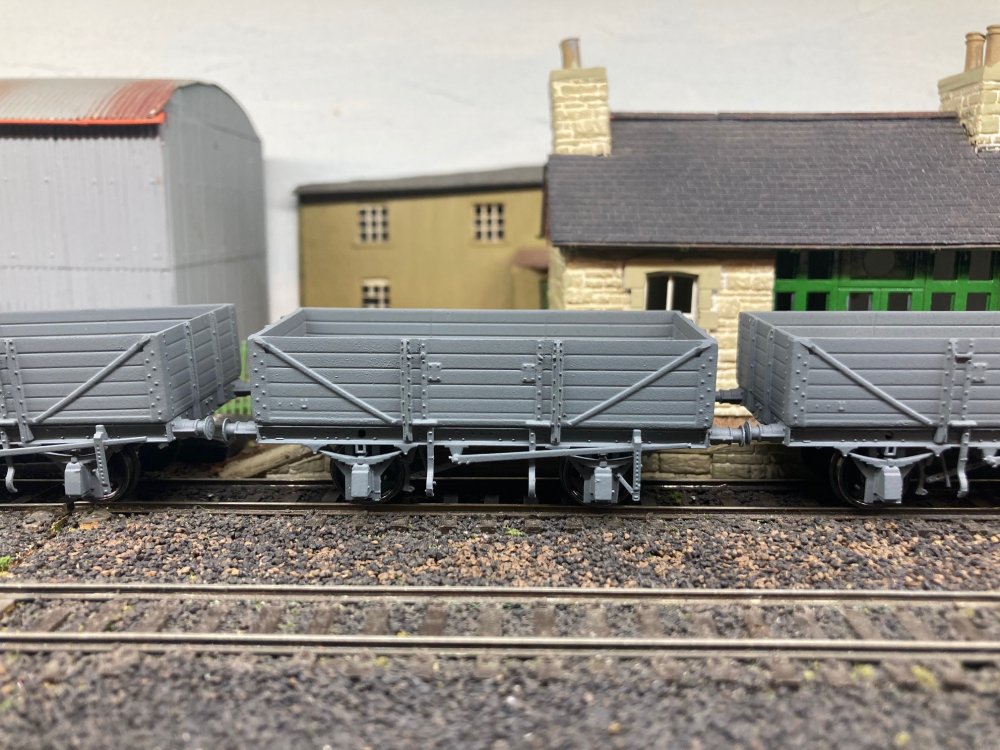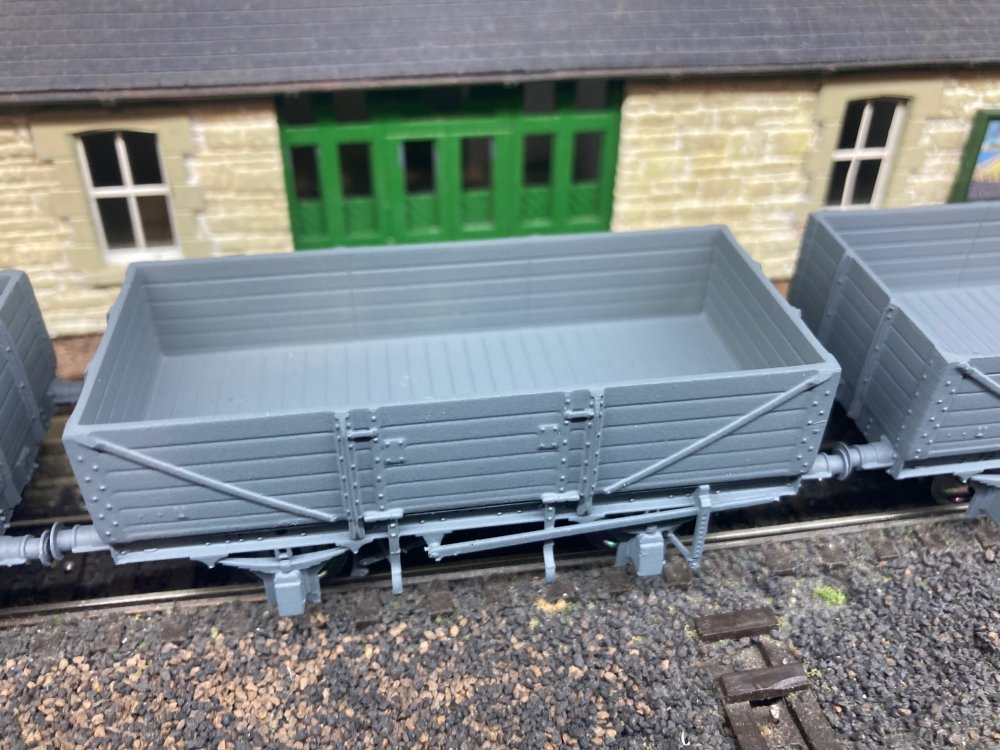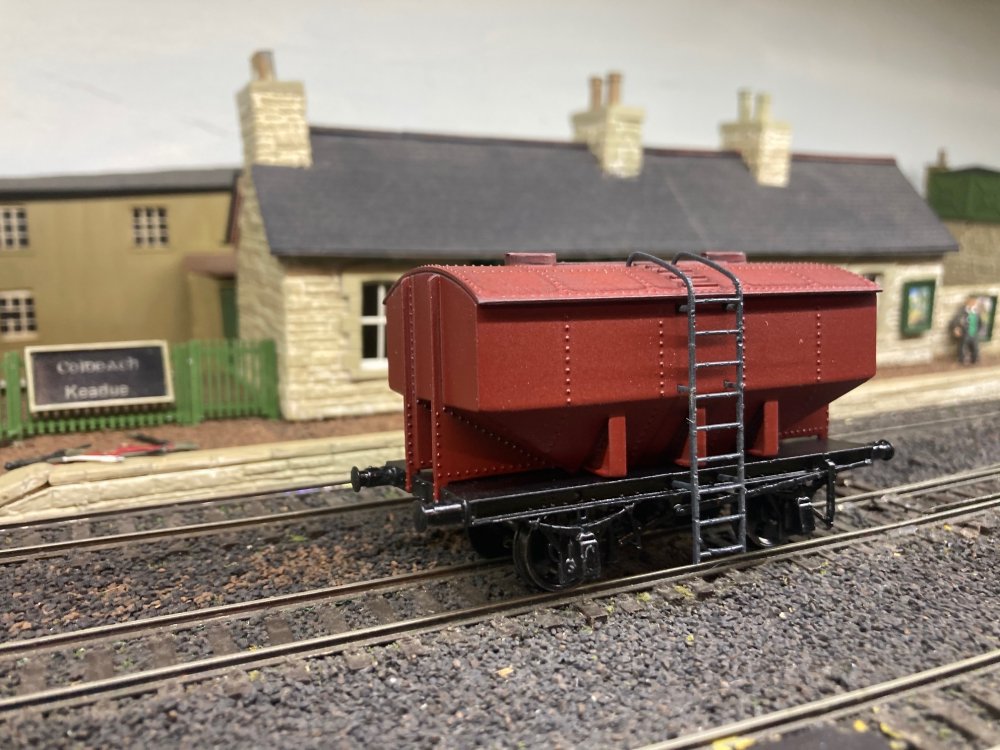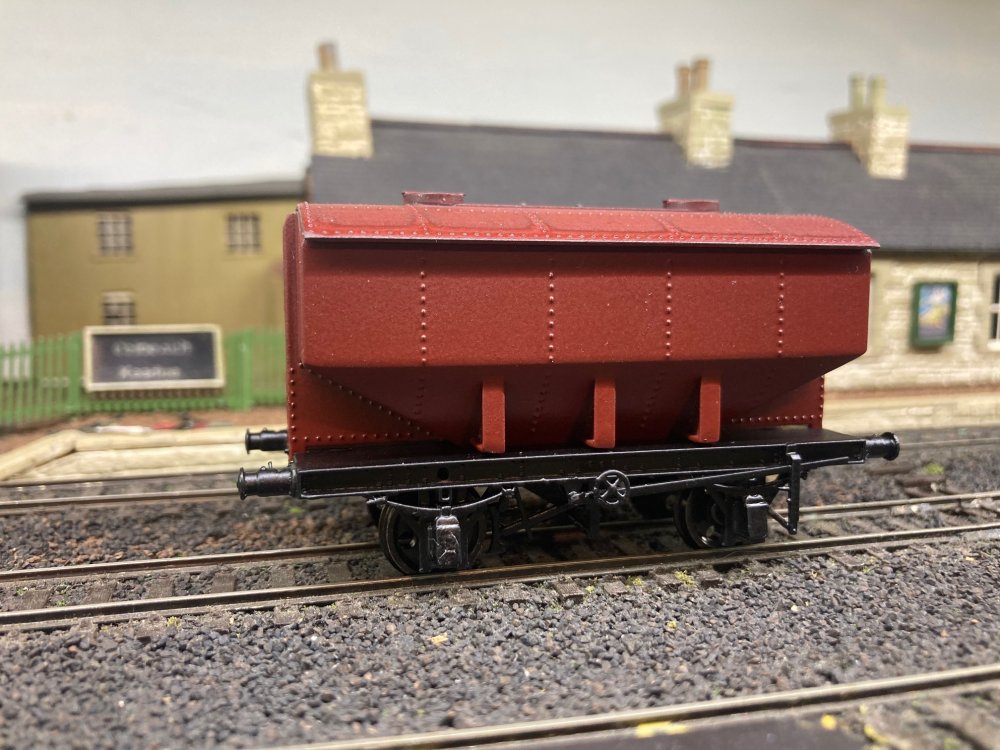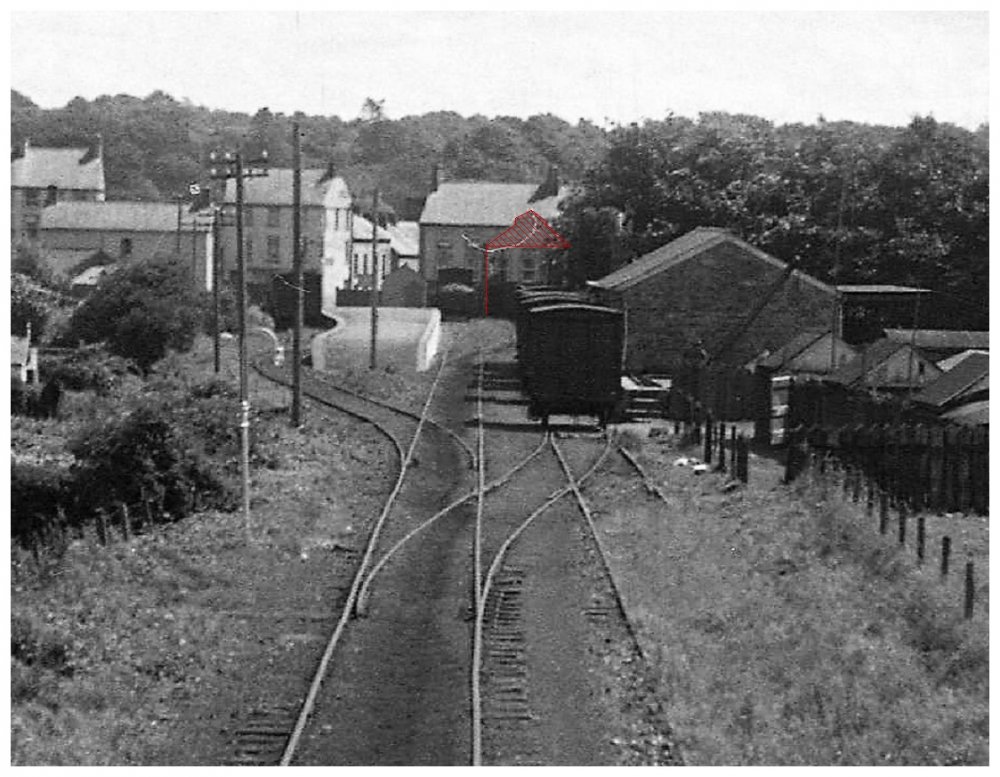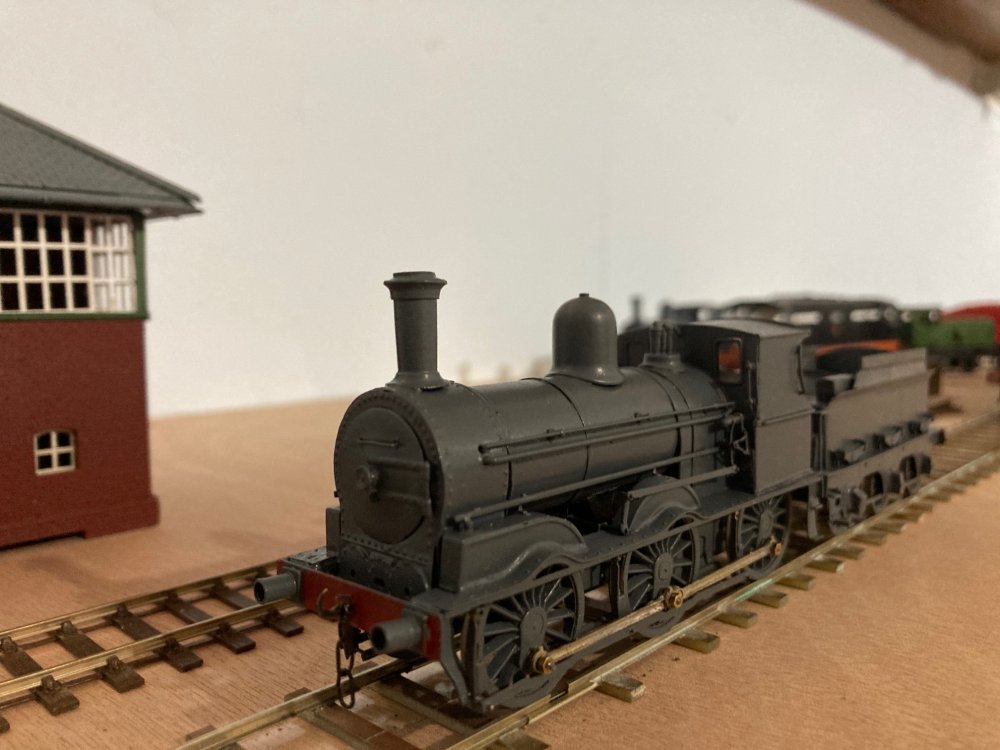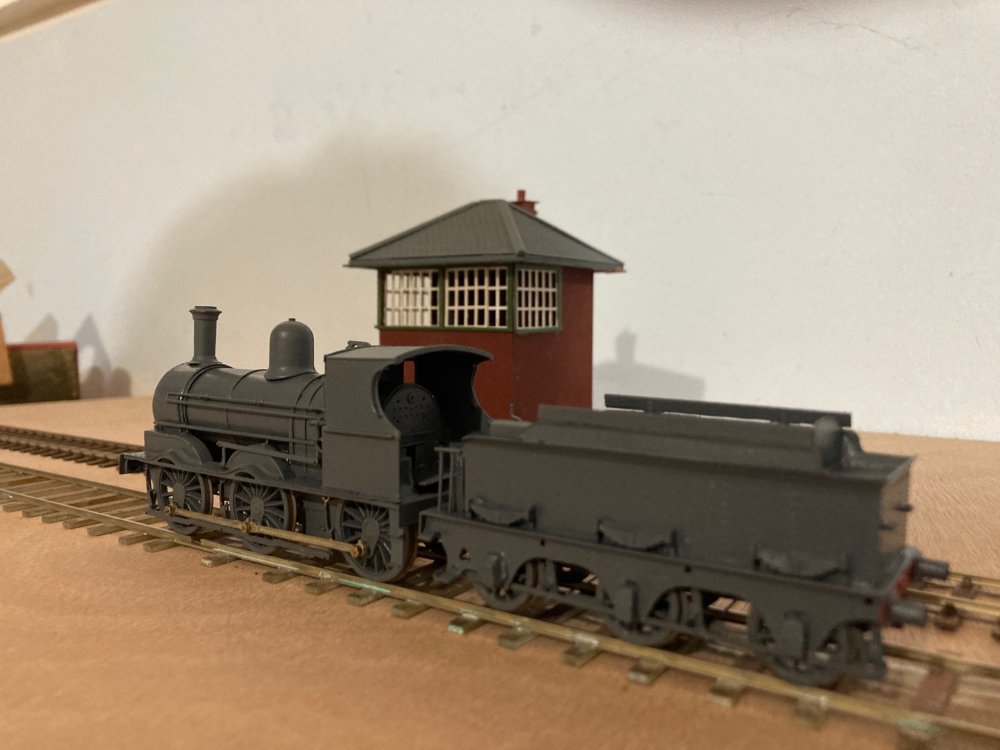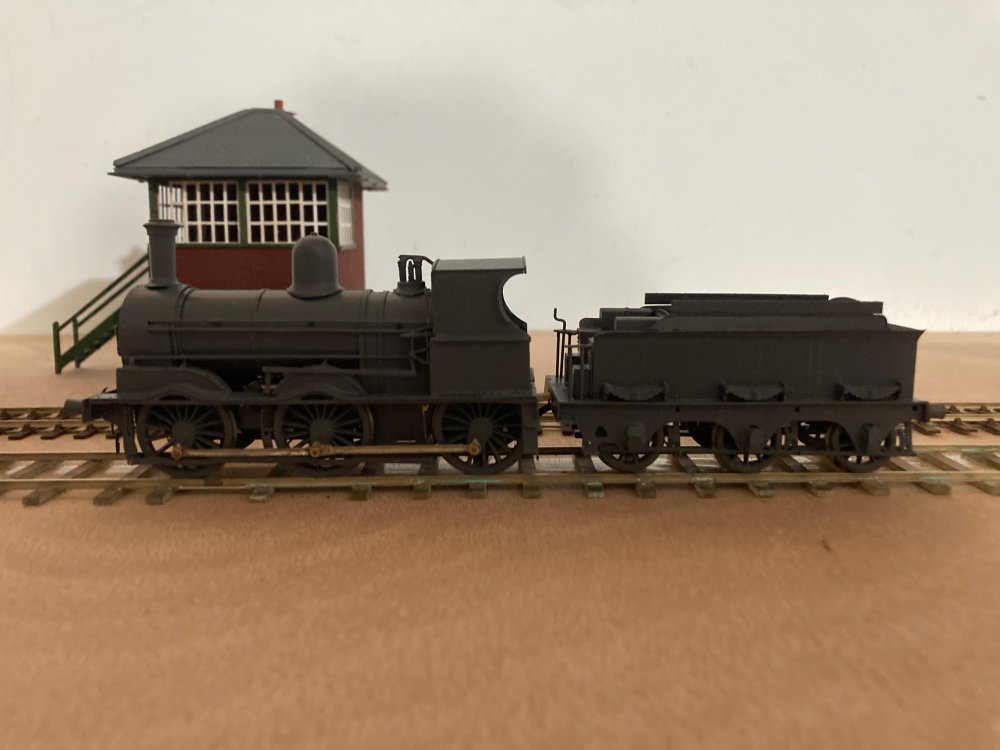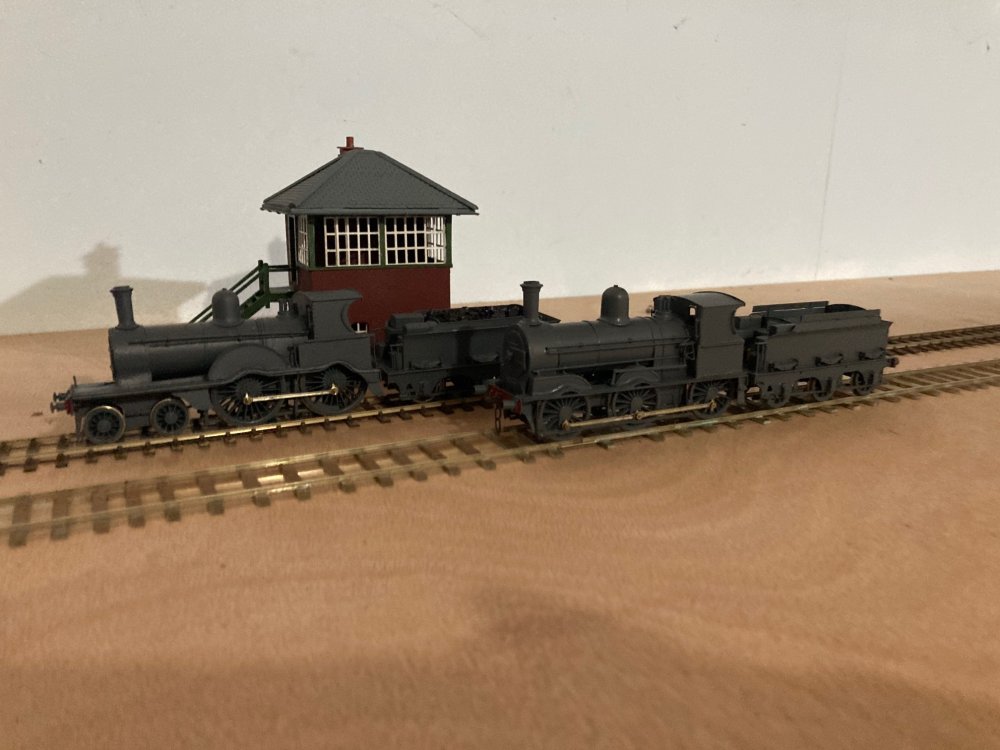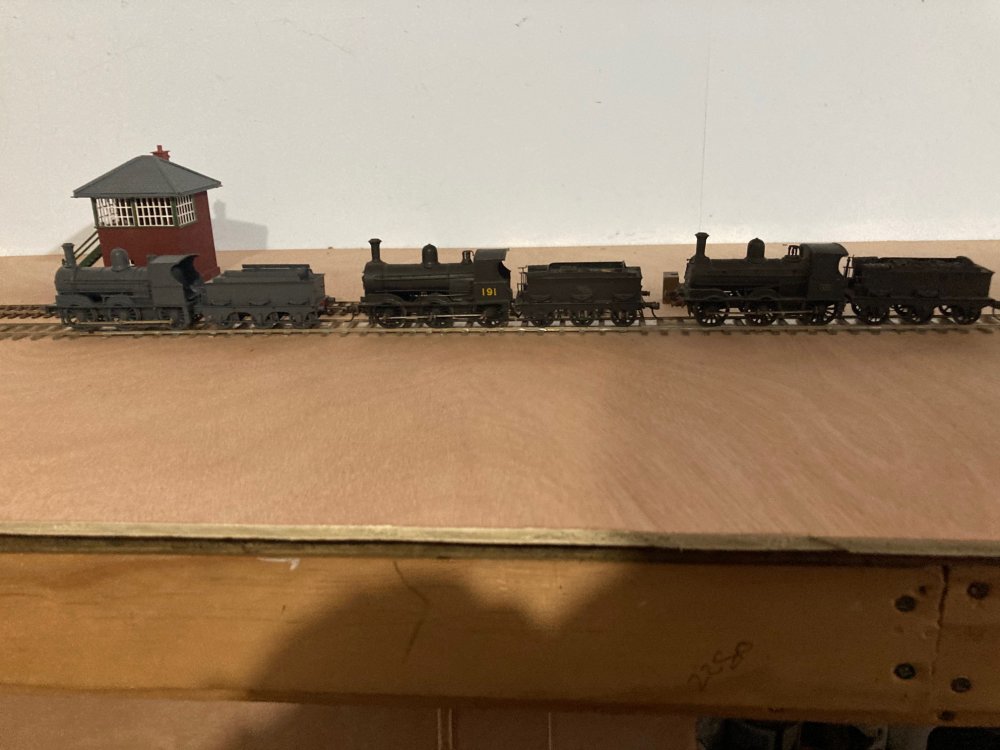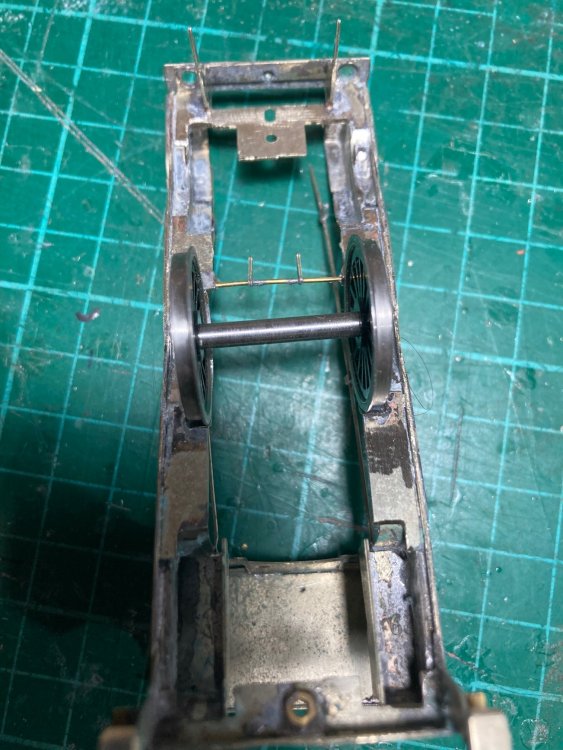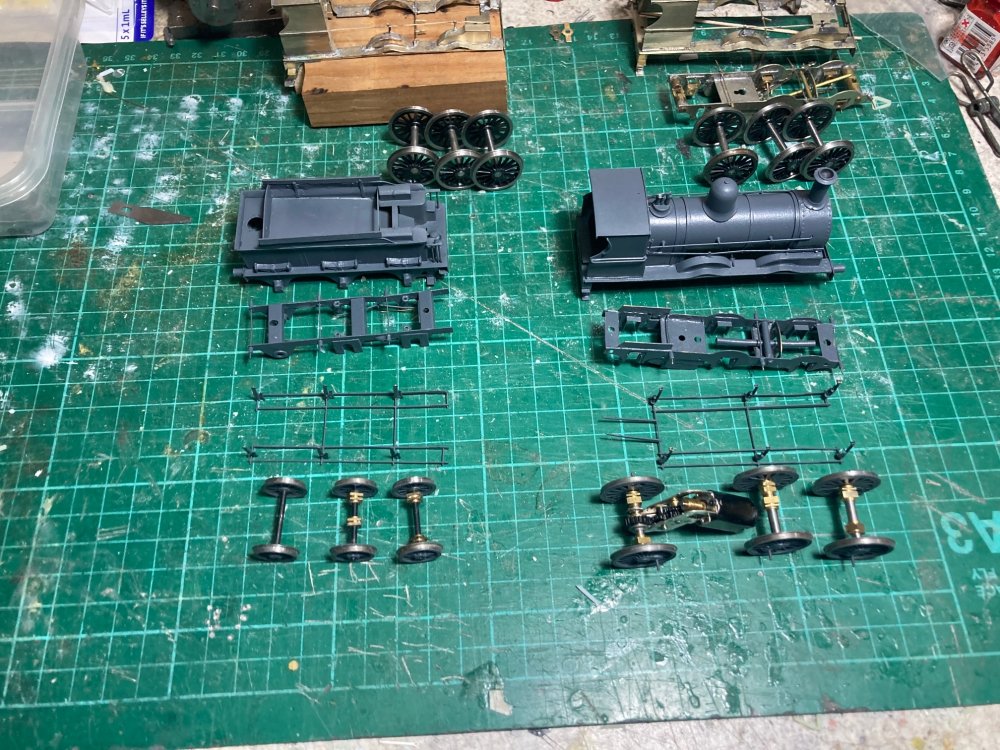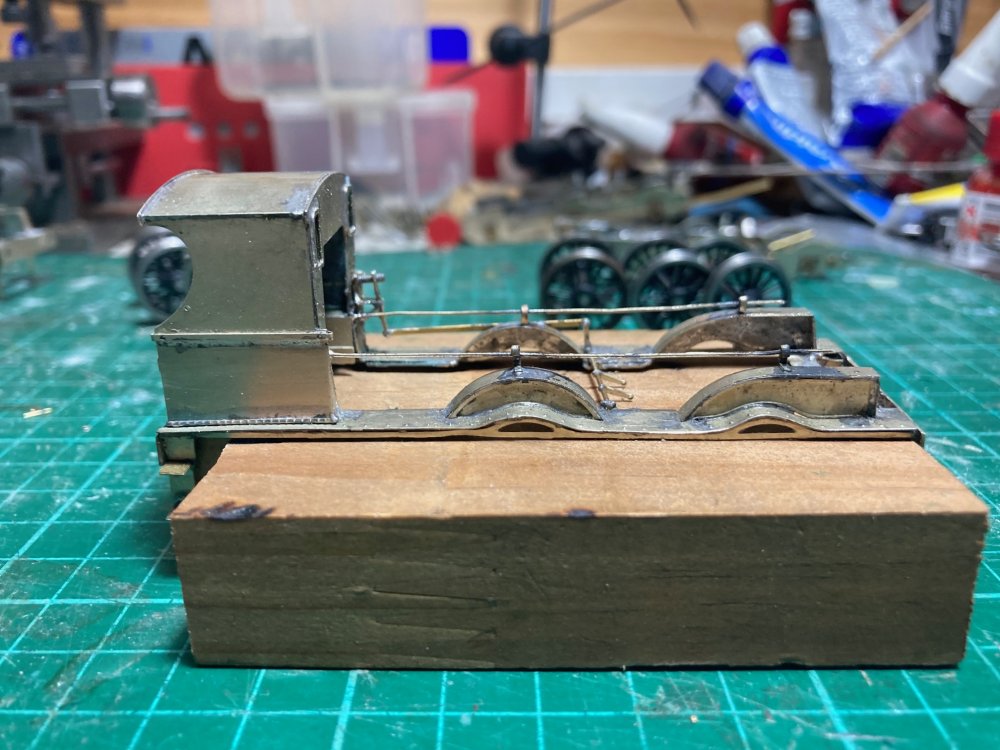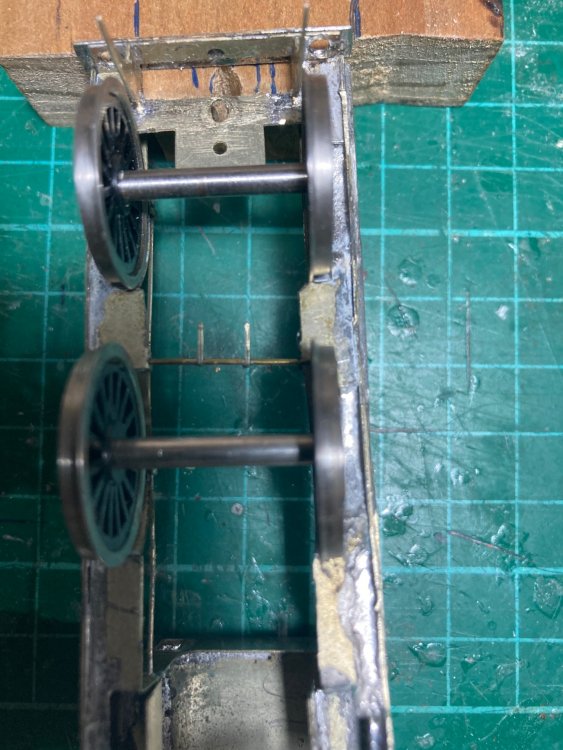-
Posts
4,873 -
Joined
-
Last visited
-
Days Won
119
Content Type
Profiles
Forums
Events
Gallery
Everything posted by Mayner
-
Irish Wagon Range: We began June on a high note with the arrival of the test prints of a new model the GSR version of the IRCH 10T Standard Open wagon and an updated version of the GSR bulk grain wagon. We ran multiple test prints to identifty potential weaknesses in the CAD work under repetitive manufacturing conditions as we ran into problems with the grain wagon discharge gear and had to make a number of amendments to the brake van despite a number of successful test prints. The opens have turned out well but it looks like we missed out the bolt head detail of the diagonal strapping. The painting was a rush job the prints arrived this afternoon, the grey is a self etch primer, the red oxide a primer coat. I have a 1950s black and white photo of what appears to be a red hopper with black underframe and running gear. Discharge side our designer had fun and games modelling the linkages that operate the discharge gear with three attempts before coming up with a workable solution. Although the open and grain wagons share a 'common' standard IRCH/GSWR/GSR underframe the two types of wagons have buffers and suspension system (springs and hangers) which we have captured in the models. 20T Brake Van: We ran into some problems during the manufacture of the first batch of vans which has had a knock on effect on completing and assembling the wagons. It was necessary to re-design & strengthen some of the finer parts to minimise breakage during assembly as SLA prints are relatively brittle compared to injection molded plastic. We currently completing the assembly and painting of the first batch of vans and expect to have a small batch of vans with the flying snail logo available for marketing and review purposes by late June. The next step is to establish whether its feasible/viable to reproduce the 1960s/70s wasp striping to the sloping duckets using pad printing for a rtr model or use decals as a fall back option. All our 3D printed wagons are supplied with Bachmann couplers with NEM mount and OO gauge Markits wheels on 28mm axles. The models are easy to re-gauge to 21mm gauge simply by pushing the wheels out 19mm (OO running clearances) or 19.3mm (EM running clearances). We have not established a price point or set up a website for our Irish wagons at this stage as the viability of producing the wagons as rtr models or kits hinges on the successful completion of the Brake Van as our first 3D printed model and the ability of our suppliers and contractors to deliver. 52 Class & Tin Van Kits. We currently have the etched and cast metal parts for the 52 Class kit in stock. The castings for the tin van kits are in stock and the etched parts for the Post Office/Tool Van and final test etch for the revised Heating & Luggage and Luggage Vans are on order currently with a 4 week lead time. Some of the detail parts for these kits are out of stock with our suppliers in the UK mainly as a result of increased demand arising from the resurgence in modelling as a result of Covid restrictions in the UK and Europe. Our planned release of the 52 Class in July-August and the Tin Vans in Aug-September is dependent on these suppliers.
- 4 replies
-
- 23
-

-

-
The gable end of the Tram Shed appears to be visible in the right background. According to the diagram the station building and platform are behind the trees in the right distance. The "platform" visible in the photo is the goods/cattle loading bank. Excellent not quite minimal space station shades of Bishops Castle with the station at right angles to the running line
-
I am quiet happy with the way the 'Grey Engine" turned out as the original builder "gave up" on the loco after running into difficulties assembling a working chassis. The builder ran into similar difficulties assembling a number of locos to S4 standards and I picked up the J15 together with 4 other part built TMD loco kits at a UK exhibition. The J15 is a good example of how metal kits are nearly always salvagable as a lot of parts were missing and the chassis was nearly a write off, although the original Protofour wheels were not usable I used the motor and gearbox to re-build a C&L 4-4-0T.
-
Cannot criticise the support group too much for their lack of reality. There is only one way to gain experience in restoring and running a railway, though talking and considering the advice of other preservation groups helps. The big questions are whether there is a written agreement in place between the Council and the Support Group to restore the railway and whether there is anything in the 2021 or 2022 Budget to finance or underwrite the restoration otherwise nothing happens. In a way the Tralee steam railway is in a similar position to the Welsh Highland Railway during the 1960s after spending several years overcoming Caernarfon County Councils objections to restoring the northern end of the railway, the Council was abolished and negotiations had to start from scratch with the newly established Gwynedd County Council which ultimately delayed the restoration of the railway for 30 years. I won't go into the internal in-fighting between the pragmatists and dreamers within the original preservation group but at the end of the day the dreamers won and the pragmatist lost, but that another complicated story. Going back to JHBs point on passenger numbers passenger numbers the busier NZ preserved railways would have a similar operating pattern and carry similar passenger numbers to Downpatrick https://www.rnz.co.nz/news/business/416927/glenbrook-vintage-railway-seeks-passenger-support-for-historical-train, other lines carry far few passengers operate once monthly or less frequently, on the majority of lines locomotive and rolling stock restoration and maintenance is financed, by individuals and groups with little or no public money.
-
Going on from JHBs "rant", I think the underlying problem is that there is an expectation in Ireland for someone else (Councils, Government and EU) to solve their problems and fund their pet projects rather than try and fund a project locally. Comparing sporting bodies like the GAA with several hundred thousand of a membership and railway preservationists who can probably muster a couple of thousand across the Island of Ireland is a bit like comparing apples and bananas. Put simply fixing 5T and re-opening the Tralee Steam Railway is not going to attract a lot of votes when there is a problem with affordable housing and hospital waiting lists. Many of the preserved railways and museums in the UK were established and operate without Government support, some such as the Dartmouth and Vale of Rheidol and Brecon Mountain are fully commercial operations usually owned by wealthy individuals or family trusts as their own private railway without a supporters group. The Festiniog is a hybrid the railway was rescued by a group of wealthy individuals in the early 50s and controlled by a group of Trustees appointed by the owners with a large supporting society. Some of the preserved railways and museums in the UK are not unlike the RPSI established by enthusiasts in the 1950s and 60s largely dependent of sympathetic railway officials, volunteer and enthusiast support. I don't buy the Ireland is too small and spread out to support preserved railway or museums, New Zealand has similar population to Ireland spread out over the land area of the British Isles, with preserved railway and museums at most major centers over the length of the country. Although there is some local government support very few could be classed as financially viable, with restoration, repairs and maintenance funded by the owners and preservation groups. Another big difference for NZ and Ireland is Kiwi Ingenuity or No 8 Baler Wire Mentality being in a remote country people had to work out solutions for themselves. The South Island practice of restoring steam locos that were dumped in rivers is probably the best example. https://www.waimeaplainsrailway.co.nz/rogers-K92
-
One down two left to go! The White Engine now the "Grey Engine" successfully re-assembled and test run though there is some work left to do including weighting the tender, finding and fitting buffer heads, lettering/number plate and couplings. Interestingly the GSR grey looks darker when viewed under soft lighting on the "layout" rather than a daylight bulb on the workbench. The loco test run without any sign of shorting despite full brake gear and very tight wheel/splasher clearance and runs slightly shorter than my two older J15s 191 & 193. Some work on 229 & the Z boiler loco grinding off excess metal and solder inside the splashers and test fitting a set of AGW driving wheels set with a 19.3 B-B leaving cigarette paper wheel-splasher running clearances. I am very reluctant to reduce to reduce the B-B Gauge to 19mm and adapt OO running clearances as this is likley to lead to running problems with the majority of my 21mm gauge locos which are fitted with the narrower Sharman driving wheels.
- 58 replies
-
- 12
-

-

-
Just like the the protests about moving 5C Slieve Callan to Moyasta for restoration & Oliver Moylan refusing to get off the loco. https://www.irishtimes.com/news/restored-steam-engine-back-on-the-tracks-after-57-years-1.691033 I wonder how many would pitch physically or financially to restore the loco or re-open the railway.
-
With its focus on railcar operation the Donegal was down to a few steam crews in its final years presumably with maintenance staff focusing on essential maintenance and little time for cleaning steam locos. Interesting the shiny dome and the fallout from smoke and ash on the cab & sidetanks. There was an interesting weathering pattern on the coalfired black Cumbres and Toltec steam locos (still 3' gauge) The upper part of the locos were weathered grey with ash with only the vertical surfaces black and a hint of a sheen on the sand and steam domes, on American locos the smokebox and chimney is usually painted with a heat resistant graphite paint. Interestingly the weathering appears much more subdued and less noticeable in photos than when I saw the locos in operation. The neighbouring Durango and Silverton locos appeared to be cleaner possibly different coal source or a greater focus on cleaning and presentation. While the C&TS appeared at least to me to be the more "authentic" of the two railroads, the boxcar (generator car) was a nice tribute to the days of the weekly "Silverton Mixed" which operated in the 1950s
- 136 replies
-
- 1
-

-
- class f
- west clare
-
(and 1 more)
Tagged with:
-
It looks like the boiler was lifted and the tubes cut out for a boiler inspection with the section of running board between the buffer beam and smokebox removed for access. The boiler and firebox require major work or replacement, the current boiler appears to date from a 1906 rebuild due to age, 53 years work in railway service and 62 years deterioration while in preservation. The loco was in regular use on the T&D up to the mid 1940s and was heavily used putting up the highest mileage of the three ex-T&D locos during its 10 years service on the Cavan & Leitrim. The loco basically needs a wealthy sponsor or a group prepared to put commit serious money to restoring and maintaining the loco
-
The basic problem is that 5T would require a sponsor or a group willing to commit upwards of €20-30,000 annually without the expectation of a return to a fund the overhaul and maintain the loco. I had an involvement with a narrow gauge (mainly volunteer) Welsh Highland Heritage Railway in the UK of similar length to the Tralee and Blennerville, fare income just about covered operating costs (fuel, oil, running maintenance) but not the cost of restoring and overhauling locos and rolling stock which is funded directly by society members, appeals and bequests. During the last 20 years over £100,000 was raised by donations (membership and general public) for the overhaul of the railways flagship Hunslet 2-6-2T locomotive Russell, Bagnall 0-4-2T Gelert was fitted with a new boiler in 2018 as a result of sponsorship and direct funding by the owners, two replica bogie coaches were constructed and the restoration of a Baldwin 4-6-0PT commenced as a result of a bequest by a late member. The preservation society is small by UK standards with approx. 1000 members.
-
That's an interesting train consist 2 4w Post office vans, TPO followed by a Park Royal------------possible location Cork Coaching? The B101s were pretty much as "Southern" loco working on the GSWR system, Dublin-Cork, Dublin-Waterford and Waterford-Limerick mainly on freight and mail trains after the introduction of the B141 Class. In they worked Heuston Goods-North Wall transfer freights and Parcel Trains to Dunlaoire . My first sighting of a B101 was in the bay platform (old station) in Dunlaoire with a parcels train, I noticed the shape of the loco and bogies were different to a Metrovick. There usually appeared to be a B101 at Liffey Bridge Junction (waiting to depart with a transfer freight for the North Wall ) when I passed on the 23 bus on trips to the city center or visits to relatives on the Northside. The loose coupled transfer freights were usually banked by an E Class from Island Bridge Junction through the tunnel to Cabra.
-
Going back to the original question my understanding is that 5T was originally loaned by the GSRPS to the company the Tralee and Blennerville Railway with the owners having (very) limited access to the locomotive. I also understand that there is considerable resistance to removing 5T from Blennerville to another restoration site. The Tralee and Blennerville was expected to operate on a fully commercial basis financed under a Business Expansion Scheme (BES)that allowed the company shareholders to obtain tax relief on their investment. https://www.companyformations.ie/other-services/business-expansion-scheme-bes/. Its likely the company ceased operation once it became obvious that the railway was not generating sufficient income to pay staff, maintain locomotives rolling stock, way and works and that additional capital investment or loans were required to overhaul 5T. It looks like the Tralee Council and more recently Kerry County Council are reluctant to get involved for similar reasons.
-
I have been asked to produce the etched parts for the above locos to 2mm scale by re-scaling (shrinking) the artwork and reducing the metal thickness from 0.4 to 0.2mm. The 52 Class fret includes loco body and loco and tender chassis. The Ks/650 includes loco and tender body and loco and tender chassis for the round topped boiler version with MGWR Canopy and Inchacore style cabs. If anyone is interested please PM or reply to this thread.
-
- 1
-

-
007 a hero of a locomotive should never feel bad! 007 came to the rescue in 76 or 77 when a north bound passenger failed near Templemore. An IRRS special from Youghal to Dublin was blocked at Thurles, 007 was on Pilot Duty at Thurles worked wrong road around the obstruction. Thurles shed was still in operation complete with a 26000 series pallet van loaded with spare parts and stores in the Bay Platform, presumably the shed would have been very busy in the Beet Season, a base for Lisduff Ballast trains and Pilot Loco for shunting and Thunderbird duties although that term did not evolve for another 20-30 years! Not sure what would happen these days if a loco hauled MK4 set failed on the Main Line no pilots or locos to rob off Cork Line freights
-
Interesting evolution from a standard American assembled single cabbed export design to a locally assembled double cab design using standard EMD components to designing and building locomotives under license for export and domestic market. https://en.wikipedia.org/wiki/RENFE_Class_319_(early_versions) The Macosa version of the 319 Class appear to have a lot in common with recent Clyde Engineering practice with large angular car bodies and cabs http://www.auscisionmodels.com.au/G Class Locomotive (Series 1).htm
-
Mechanically and electrically the 141 and 071 are standard EMD export designs custom built to the customers requirements using standard components, hence the similarity in cab design between the 141/071 and the RENFE 319 & Yugoslavian 003. During the 1950s EMD supplied 382 standard G8 (8 cylinders) and over 1100 G12 (12 cylinder) export locomotives to railways in Africa, Asia, Australia, Europe South and Central America. These locos were based on North American road switcher design with single cab and narrow car body available in Bo Bo, A1A A1A or Co Co wheel arrangement. The lightweight GL6 & GL8 models were developed in 1960 in response to customer demand for a light weigh low axle load locomotive as the standard G8 shared the same body and running gear as the G12 was considered cumbersome with a low power to weight ratio. The EMD assembled GL6 & GL8 which included the CIE 121 Class was an end cabbed design of similar appearance. The GL6 was a 3 axle C or 0-6-0 design supplied to the Lebanon, the 149 GL8 were supplied in A1A A1A for to railways in Asia, the Bo Bo version to railways in Tunisia, Brazil & Ireland. The Irish 121 appears to have been the only raised cabbed version the majority of GL8s were built with the cab roof flush with the hood. Clyde Locomotive Works built an Australian version of the GL8 supplied in narrow (3'6"), Standard and Irish Broad Gauge with distinctive cab and car body styling. The GL8 morphed into the JL8 or double cabbed 141 Class in 1961 which subsequently developed into the JL18 or 181 Class in 1966. The JL8 and JL18 type appears to have been built exclusively for CIE. The 071 & 111 Classes appears to be part of a large family of GT22 and JT22 turbocharged 12 cylinder Export Models introduced in the early 70s in response to demand for high horsepower locomotives for fast freight and passenger work. The 071s are classified as JT22 CW (double cabbed, turbo charged, wide cab?) The NZR DF was introduced as the 1650hp non-turbo charged GL22MC model in 1979 and re-built to the 2400hp DFT Class to GT22 MC spec between 1992-97 for fast freight work. Apart from different appearance, gauge, usage and traction control systems the CIE 071 and the New Zealand DFT are essentially the same EMD Export Model mechanically and electrically. The 071s & 111s were originally introduce for heavy high speed passenger work, more recently used on freight and engineering duties, while the DF evolved from a slow speed drag freight duties to high speed express freight duties, with a small number of locomotives on tourist passenger and commuter duties
-
I like the Quarry Hunslet complete with smokebox door wheel!
-
The "White Engine" has finally become the "Grey Loco", I haven't decided on a number at this stage, I need to check on the locos rostered to Tuam Shed between the 1930s & mid 1950s. Sub-assemblies on the assembly bench. I primed the loco with a Finixia grey etch primer followed with a grey laquer topcoat matched to a sample of GSR/CIE paint provided by JHB. I decided to assemble "The Grey Loco" to reduce the number of incomplete projects before undertaking further work on 229 and the Superheated J15. I tidied up the splashers and sandbox linkages on both locos, the main challenge is achieving sufficient running clearance between the splashers and the locomotive driving wheels set with a 19.3 B-B gauge.
- 58 replies
-
- 10
-

-

Ernies Massive Irish 1930's to 2005 Photo Archive
Mayner replied to Glenderg's topic in Photos & Videos of the Prototype
A precursor of British Rails Freightliner trains of the 1960s GSR & CIE ran the 39 ex-CBP & C&MR open wagons in fixed formation blocks of 10 wagon with the original Link and Pin (hook & eye) couplers used on the Cork narrow gauge lines internally and the "Outer Wagons" had a link and pin coupling at one end and a Norwegian "Chopper" coupling at the other end for coupling with C&L locos and stock stock. The link and pin couplings were highly dangerous and were eventually banned from interchange service in the US and replaced with knuckle couplers. -
To be frank the simplest/easiest approach at this stage is probably to continue your 3D modelling approach by designing and printing your own models as apart from the Worsley Works scratchbuilder parts no commercially produced CDR locos or stock is available. Although Backwoods Miniatures and Nine Lines produced CDR stock in the 1990s demand for Irish 3' gauge models sales were disappointing both companies focusing on the more profitable OO9 side of the business and discontinued their Irish 3' gauge models. Nine Lines commissioned Parkside Models to produce plastic injection molded kits for a CDR open wagon and covered van in the early 1990s. It might be worth joining the OO9 gauge society or the Irish OOn3 Facebook group, as society/group members may have CDR stock/kits for sale.
-

Track centres for double and passing tracks
Mayner replied to Tisim's question in Questions & Answers
Minimum clearance between running lines appears to have been 6' as used in the UK, I have a MGWR Loading and Structural gauge apparently from the early 1900s that shows 6'25/8" between adjacent rail centers for double track & 2'4" between rail center and platform faces. -

Killester Nocturnal Trains of the Early Eighties
Mayner replied to DJ Dangerous's topic in What's happening on the network?
We live in an eastern Hamilton suburb about half a mile from a railway line with about 30 freight movements daily with several at night. Most noticeable thing is the low rumbling of long eastbound freight trains that can be heard for several minutes before passing through our suburb. The city is in a wide river valley basin with a distant range of hills on the western side, so sound travels a long distance in calm conditions. Until fairly recently we had a nice mix of loco sounds with the deep rumbling of American General Electric locos with 4 stroke engines contrasting with Turbo and non Turbo 2 stroke General Motors sound now largely replaced with Chinese built DL Locos with their screeching high revving MTU (Maybach) power units. The General Electrics were upgrades of the 2700 hp U26C model dating from the early 70s two of which were rebuilt to C30-8m specification with reconditioned 3250hp power units sourced from GE. The C-30-8m rebuilds had a distinctively different sound to the 2700 hp locos and the two members of the sub class were rostered to the Metro Port container trains that pass through our neighbourhood until transferred to the South Island following the introduction of the DLs. Going back to Ireland, I once spent a week in a Fawlty Towers style seaside hotel in Bray while attending a training course during the early 80s, whatever else it was an excellent place to stay and listen to 001 Class climbing the grade from the station to Bray head with empty fertiliser and laden Ammonia trains to the Shelton Abbey NET plant. On average there appeared to be three South and a similar number of North bound movements most nights, at the time a lightly loaded Wexford Liner operated during daylight hours usually a half dozen 4w container wagons attached to the rear of a Fertiliser Train between North Wall and Shelton Abbey. -

Killester Nocturnal Trains of the Early Eighties
Mayner replied to DJ Dangerous's topic in What's happening on the network?
As a teenager in the early 70s I used to go to the Model Railway Society of Ireland North Richmond Street clubroom on a Friday night. The sound of goods trains (particularly on a cold frosty night) climbing the grades from the North Wall to Liffey Junction with a loose coupled goods train was something else with an A or Ar leading a long slow moving train of wagons with an E Class banking at the rear. -
Interesting one A25 is fitted with deflectors apparently to reduce wind turbulence around the snatchers while exchanging ETS staff at speed. The coaches appear to be relatively new Laminates a large number of which (over 60) were introduced in 1958-59 and would have allowed reasonably uniform rakes to be made up for the Cork Expresses and other prestigious trains until they became due for heavy repairs. The leading coach is a 1909-1913 main line Brake Second a type that was usually marshalled at the South end of Main Line trains, presumably there is an older CIE "Bredin" style Buffet Car and a 1st Class Coach or Composite marshalled towards the rear of the train coupled to a 4w Heating and Luggage Van.
-
Courtaulds Carrickfergus, the four CSE Sugar Factories and the two NET/IFI fertiliser plants are probably the best examples of relatively modern large scale rail served manufacturing/process plants in Ireland. The main drawback in trying to model such large scale operations is the the sheer amount of space required to model either the marshalling yard or manufacturing/processing plant and limited operation potential compared to the more compact Victorian/Edwardian area operations such as Allman's Distillery in Bandon, and private sidings that served the milling industry and Ulster's Linen Industry. In its heyday in the era before Prohibition Allman's Distillery would have received coal and malt (bagged) in open wagons and sent out the finished product in covered tramway with "Pat" and its predecessor shunting wagons within the distillery and along the private siding tramway to the main line connection at Bandon Station. Similarly private sidings at stations such as Clara and Ballysodare generated a considerable volume of freight traffic, Clara was a particularly busy station in the wagon load era with private sidings serving Ranks Mill and the Goodbody textile factory which were shunted by a pilot loco (a G 601 in later years) that also worked the Banagher Goods The Goodbody mill received jute possibly in open wagons and dispatched the finished product in covered wagons. Ranks mill would have received grain in covered hoppers and possibly dispatched flour or animal feed in covered vans before the traffic was lost to rail. It could be argued that CIE lost a lot of traffic to road with its fixation with fixed formation Liner Trains in the 70s, with large shippers such as Bord na Mona, the Irish Sugar Company, Cadburys and grain millers shifting to road transport following the closure of the majority of private sidings in the 70s. Although the sugar company continued to be a major shipper rail was used mainly for long haul traffic from South Wexford to Thurles and later Mallow and between North Kerry and Dundalk/Navan to the Tuam Factory with Carlow the most productive plant served exclusively by road.
.png.c363cdf5c3fb7955cd92a55eb6dbbae0.png)

